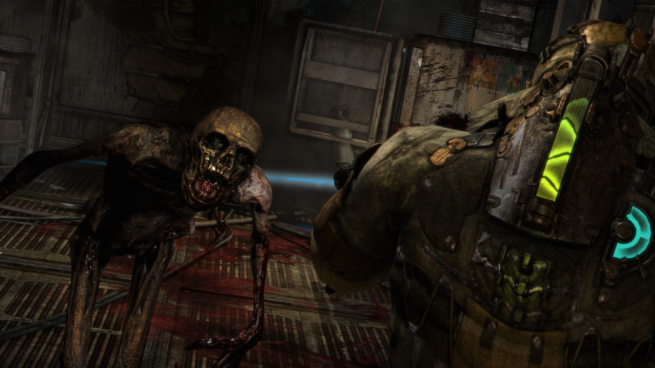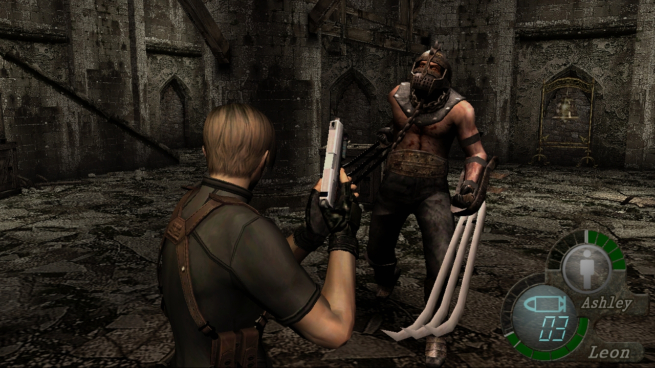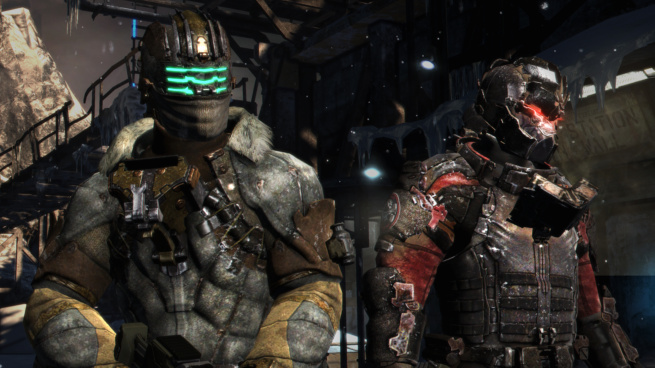After watching the 20-minute official gameplay video for Dead Space 3, the thing I find most scary is the fact I didn’t find anything scary at all.
The third installment of Visceral Games’ sci-fi survival-horror franchise features an all-new cooperative mode and cover-based shooting. Lead character Isaac Clarke mows down his foes with automatic weapons and a seemingly inexhaustible supply of ammo. He can now do a nimble dodge — a pretty impressive feat in a metal engineering suit. He and his new partner, John Carver, trade barbs and banter, doing their best Marcus and Dom impersonations as they partake in big, action-packed set-piece battles against giant necromorphs and human Unitology soldiers.
Frank Gibeau, president of EA Games at publisher Electronic Arts, tells Computer and Video Games that EA added these elements to open the game up to a wider audience.
“In general, we’re thinking about how we make this a more broadly appealing franchise because ultimately you need to get to audience sizes of around five million to really continue to invest in an IP [editor’s note: intellectual property] like Dead Space. Anything less than that and it becomes quite difficult financially — given how expensive it is to make games and market them,” Gibeau says.
But in its attempt to reach a broader range of people, EA might be ruining what made the series great in the first place: the horror. By giving Isaac a bigger arsenal and a buddy, Visceral is seemingly removing the sense of powerlessness and isolation that is a central element of the genre. Thomas Grip of Frictional Games, the independent studio behind the supremely scary (and combat-less) Amnesia: The Dark Descent, says that’s not how you make a proper horror game.
“It is not like games like Dead Space are bad games per se,” he says. “I actually enjoyed it quite a bit. But that enjoyment comes from the same stuff that makes you enjoy a splatter movie. It’s not because of it being a good horror game. The market is so saturated with games about shooting stuff that I really find it tragic that you take the one genre that has helped bring so much new to the table in terms of interactive atmosphere and storytelling and just add it to that pile.”
“Horror…is the one genre where players are okay with skipping conventions and a focus on pure fun in order to get a different experience,” Grip adds. “This is a chance to try new things and to bring innovative storytelling devices to a broader market. This is your chance to attract a new audience, but instead, big publishers are all just trying to get a piece of the same market.”
Dead Space isn’t the first survival-horror series to slowly take the action route. The long-running Resident Evil franchise received a makeover in 2004, adding an over-the-shoulder camera perspective, laser-assisted aiming, and context-sensitive controls. Developer/publisher Capcom would later add a co-op mode to Resident Evil 5 in 2009. The next RE game, due to hit store shelves this October, will feature three sets of characters playable in both single player and co-op.
“Resident Evil 4 and Resident Evil 5 were played and enjoyed by a huge audience, and just as many gamers love the style of the older games,” says Resident Evil 6 producer Yoshiaki Hirabayashi. “There are also many who tell us that they prefer the style of the more recent titles. Knowing that both styles are appreciated, we are working night and day developing Resident Evil 6 with a view of bringing the best game experience to the widest audience we can.”
It’s a strategy that seems to be paying off for Capcom. Resident Evil 5 sold more than 5 million copies, breaking a franchise record. Industry analyst Jesse Divnich from Electronic Entertainment Design and Research (EEDAR) tells GamesBeat that while broadening a game’s appeal can cause discontent in loyal customers, no data suggests that it impacts sales. “In fact, there is more data to support that broadening appeal increases sales rather than decreases sales,” he says.
Video games with multiplayer components sell more units on average than games without, Divnich adds, but the way in which developers integrate multiplayer is key to a game’s success. “Simply tacking on a multiplayer component because the ‘data says so’ is never a good idea, but I am hopeful that the bright people at EA understand that and [that] any co-op inclusion into the Dead Space franchise will be well thought out.”
Dead Space 3 executive producer Steve Papoutsis says he couldn’t be more excited with the leaps forward that the franchise has taken. “We feel like we’re doing something really unique with co-op where it’s completely optional and almost like having two games in one,” he says. “Players will get updated cutscenes, increased dialogue, and even side missions specific to the new co-op character. We also think it’s going to be fun for our fans to play through the Dead Space terror with a friend. It’s just like going to a scary movie with a buddy, so you can share that horror experience together.”
Bringing new experiences to a genre in a way that appeals to audiences both new and old can be a difficult challenge, but both Papoutsis and Hirabayashi say that it’s important their franchises evolve. “We always approach the development of a new Resident Evil game from the perspective of making it the best game we possibly can,” says Hirabayashi. “We want to bring to our users experiences that are both fresh and true to the series, and that invariably means making changes as the series progresses.”
“[Evolution is] ‘a gradual process in which something changes into a different and usually more complex or better form,’” says Papoutsis. “That can only happen by trying new things, taking chances, and remaining true to a core vision or goal. Therefore, I would suggest developers push forward with decisions that are correct for their particular franchise, which is what we’re doing with Dead Space 3, and deliver the most complete and compelling gaming experiences possible for their players.”
VentureBeat's mission is to be a digital town square for technical decision-makers to gain knowledge about transformative enterprise technology and transact. Learn More



